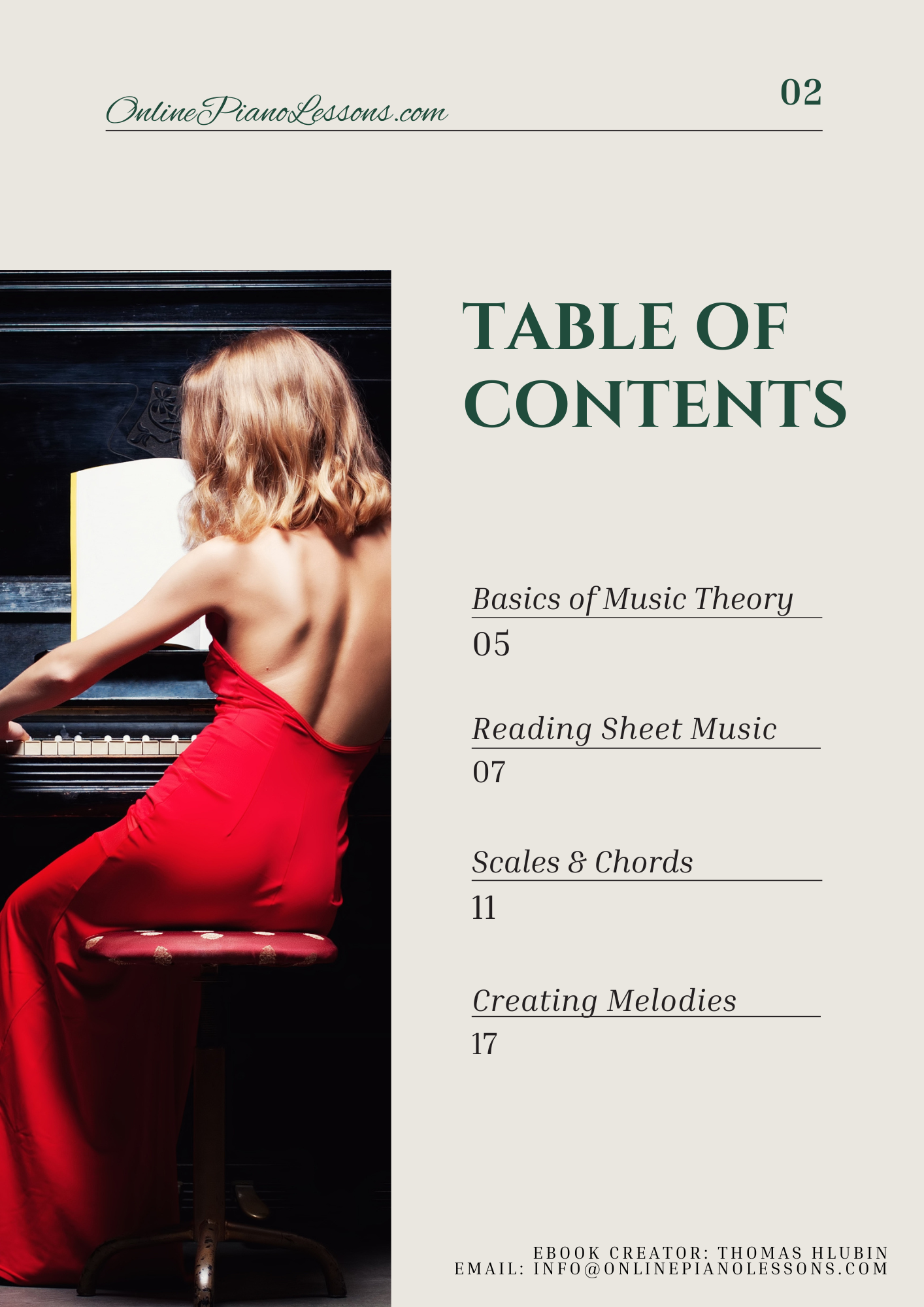The E minor pentatonic scale is one of the most essential, expressive, and widely-used scales for pianists. It’s compact, forgiving, and immediately musical — perfect for improvisation, songwriting, ear training, and adding soulful color to your playing. This definitive guide covers everything: what the E minor pentatonic scale is, how to find and finger it on the piano, why it’s so powerful, practical exercises, improvisation tips, and composition ideas. By the end you’ll be able to use the E minor pentatonic scale on the piano in creative and confident ways.
What the E Minor Pentatonic Scale Is
The E minor pentatonic scale is a five-note scale derived from the natural minor scale. “Pentatonic” literally means “five tones.” The E minor pentatonic scale follows the formula:
1 — ♭3 — 4 — 5 — ♭7
Applied to E, that gives you the notes:
E — G — A — B — D — (E)
On the piano, these notes avoid the half-step tensions found in the full E minor scale, which makes the E minor pentatonic scale sound smooth and consonant across many harmonic contexts. The result is a scale that feels natural under the hands and produces musical results quickly.
Why the E Minor Pentatonic Scale Matters on the Piano
There are several reasons the E minor pentatonic scale is so useful for piano players:
- Instant musicality: Because it removes half-step dissonances, the E minor pentatonic scale sounds natural over many chords; even beginners can improvise pleasing lines.
- Stylistic versatility: Use it in blues, rock, jazz, folk, pop, and R&B — the E minor pentatonic scale is a go-to across genres on the piano.
- Technical accessibility: Its compact shape makes it comfortable under the fingers, ideal for both two-handed comping and single-line solos.
- Great for composition: Pentatonic motifs are frequently the core of memorable hooks and riffs; the E minor pentatonic scale provides a reliable melodic palette.
- Ear training foundation: Practicing the E minor pentatonic scale on the piano strengthens interval recognition and melodic intuition.
Because of this blend of practicality and musicality, the E minor pentatonic scale is a high-ROI scale for any pianist’s practice routine.
How to Find the E Minor Pentatonic Scale on the Piano
Finding the E minor pentatonic scale on the piano is straightforward:
- Locate the note E (the white key to the left of the group of two black keys).
- From E, move up a minor third to G (E → F → F♯ → G).
- Move up a whole step to A.
- Move up a whole step to B.
- Move up a minor third to D.
- Return to E.
So the sequence to play on the piano is: E → G → A → B → D → E.
It’s helpful to visualize the pattern as a five-note shape that repeats across octaves on the piano. Because the E minor pentatonic scale uses mostly white keys with only natural flats, it’s friendly for learners and quick to memorise.
Recommended Fingerings and Technique (Piano)
Good fingering is essential for clean playing of the E minor pentatonic scale on the piano. Try these one-octave fingerings:
- Right hand ascending: 1 (E) — 2 (G) — 3 (A) — 1 (B) — 2 (D) — 3 (E)
- Left hand ascending: 5 (E) — 3 (G) — 2 (A) — 1 (B) — 3 (D) — 1 (E)
These fingerings help with thumb passage and maintain a natural hand position. Focus on relaxed wrists, curved fingers, and even tone. Practice slowly at first and use a metronome to keep a steady pulse — speed will come after control.
Practice Exercises for the E Minor Pentatonic Scale (Piano)
Integrate these piano-focused exercises into your daily routine to internalize the E minor pentatonic scale:
- One-octave runs: Play up and down slowly with each hand separately, then together.
- Three-note sequences: Sequence three-note patterns across the scale (E–G–A, G–A–B, A–B–D).
- Arpeggio outlines: Play implied triads on the scale (Em, Am, Bm) to hear harmonic relationships.
- Motif building: Create a 2-bar motif and repeat it with rhythmic and intervallic variation.
- Improv vamp: Loop a simple progression (Em → C → D) and improvise using only the E minor pentatonic scale.
- Transposition exercise: Move pentatonic shapes to other keys to build keyboard familiarity.
Short, focused practice (10–20 minutes per day) reaps quick gains in comfort and musicality on the piano.
Melodic Ideas, Licks, and Patterns
Here are immediate melodic shapes you can use on the piano with the E minor pentatonic scale:
- Simple hook: E → G → A → G → E (a singable motif)
- Ascending phrase: E — A — B — D — E (with tied notes for feel)
- Blues-flavored line: E — G — A — (G♯ blue note as passing tone) — A — B — D
- Call-and-response: Play a short phrase low and answer with a high register variation.
Experiment with dynamics and articulation on the piano — a soft legato line versus an accented staccato variant completely changes the mood.
Chord Contexts That Fit the E Minor Pentatonic Scale (Piano)
On the piano, the E minor pentatonic scale works across many chordal contexts:
- E minor (i): The scale outlines the tonic chord (E–G–B) and provides natural melodic tones.
- G major (relative major): Because E minor and G major are relative, pentatonic notes fit G major progressions nicely.
- A minor, D major, B minor: These chords are common companions in minor-key progressions and are compatible with pentatonic lines.
- Blues context (E minor blues): Add the blue note (G♯/A♭) for more traditional blues coloration.
When comping on the piano, use sparse left-hand voicings and let the right hand deploy pentatonic phrases to avoid harmonic clutter.
Improvisation Strategies on Piano
Here’s a simple approach to improvising with the E minor pentatonic scale on the piano:
- Start with a static vamp: Em → Em7 → Em7 or Em → C → D—looped.
- Use short motifs and repeat them with variation—building familiarity and tension.
- Target chord tones (E, G, B) on strong beats for resolution.
- Add space; silence can be as musical as notes.
- Use octave displacement—play the same motif an octave up or down to create contrast.
The E minor pentatonic scale’s forgiving nature makes it ideal for beginners to improvisation on the piano, but it’s also a favorite of masters who use its simplicity to craft complex emotional storytelling.
Composition and Songwriting Uses
Songwriters love the E minor pentatonic scale for hooks and vocal lines. On the piano, you can use the scale to:
- Craft short, memorable motifs that repeat as the main hook.
- Create modal or atmospheric textures by combining pentatonic lines with suspended or extended chords.
- Build intros and interludes that evoke introspection or bluesy grit.
- Layer pentatonic melody over rhythmic left-hand patterns for a full arrangement.
Because the scale is inherently melodic and easy on the ear, it’s a powerful composition tool for pianists writing songs quickly.
Common Mistakes And How To Fix Them
Beginners often make these errors when using the E minor pentatonic scale on the piano:
- Over-repetition of a single lick: Vary rhythm, dynamics, and register.
- Ignoring harmonic targets: Land on chord tones occasionally to make phrases resolve.
- Mechanical playing: Focus on phrasing and expression rather than just speed.
- Poor fingering leading to awkward runs: Use the recommended fingerings and practice slowly.
Fix these by practicing small, targeted exercises and recording yourself to hear where improvement is needed.
Practice Plan (12–20 Minutes)
- 2 min: warm-up (scales or five-finger patterns around E).
- 4 min: one-octave E minor pentatonic runs, hands separate, then together.
- 4 min: three-note sequence practice and pattern development.
- 4–8 min: improvise over Em → C → D loop, focusing on motifs and dynamics.
Daily short sessions are highly effective—consistency beats marathon sessions.
Final Thoughts
The E minor pentatonic scale on the piano is a high-value tool for players at every level. It gives you instant melodic capability, supports deep creative exploration, and helps you build confidence with improvisation and composition. Practice the shapes, explore motifs, and apply the exercises above—soon the E minor pentatonic scale will become a go-to resource in your musical toolbox.
FAQ
What notes are in the E minor pentatonic scale?
E, G, A, B, and D.
How do I find the E minor pentatonic scale on the piano?
Play E → G → A → B → D → E. Use recommended fingerings to practice smoothly.
Why is the E minor pentatonic scale useful for piano improvisation?
It avoids half-step dissonance, contains essential chord tones, and produces musical lines with little risk of clashing.
Which chords fit well with E minor pentatonic?
E minor, G major (relative major), A minor, B minor, and D major are common fits.
How long does it take to get comfortable improvising with this scale on piano?
With consistent short practice, many players start improvising musically within a few weeks.
Can I use the E minor pentatonic scale in genres outside blues?
Absolutely — it’s used in pop, rock, jazz, R&B, film music, and more.







 Hi, I'm Thomas, Pianist Composer,
Hi, I'm Thomas, Pianist Composer,  I love playing piano, creating new melodies and songs, and further developing my online piano course and making updates/additions to my site OnlinePianoLessons.com!
I love playing piano, creating new melodies and songs, and further developing my online piano course and making updates/additions to my site OnlinePianoLessons.com!  Now that is what I call fun!
Now that is what I call fun!
